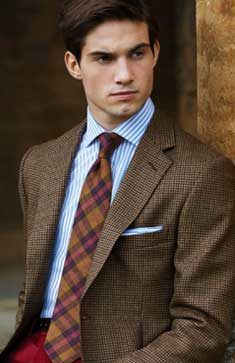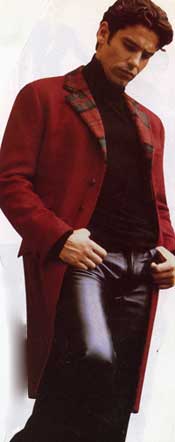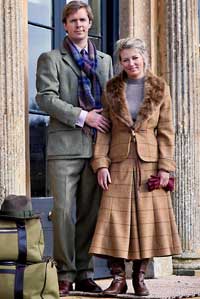|
HARRIS TWEED IS RESCUED - AGAIN
Harris Tweed emerged blinking into the harsh glare of the TV cameras, after premature reports of its death.
Like a wild beast that reappears to confound experts who have pronounced it extinct,  Harris Tweed rose phoenix-like from the latest attentions of a gaggle of well-meaning enthusiasts, in a storybook tale brilliantly portrayed in an autumn BBC series. Harris Tweed rose phoenix-like from the latest attentions of a gaggle of well-meaning enthusiasts, in a storybook tale brilliantly portrayed in an autumn BBC series.
It had an all-star cast. Splendid villain of the piece was a Mr Brian Haggas, up from Yorkshire mill; white knights were Savile Row tailor Patrick Grant and New York businessman of Scottish extraction Alan Bain; supporting roles went to some fancy fashion folk from off-island; local interest was provided by a band of recalcitrant weavers clearly under-welmed by all the attention; and female star of the proceedings was Lorna Macauley, heading up the Harris Tweed Authority, and with the uneviable task of trying to bring these disparate parties together.
To précis events covered: After a period of various problems for the industry, Mr Haggas arrived upon the scene to be greeted as a saviour, but who turned out to be the Terminator. Having equipped a mill with all the latest equipment and promised a new era of success for the iconic tweed, Mr Haggas promptly reduced output from around 8,000 patterns to 4. Then, determined to control the world market for Harris Tweed jackets, he took all production of the four to make 70,000 jackets in Yorkshire of a styling that would certainly not frighten the horses.
It was a joy to watch the hapless Mr Haggas (dictionary definition of hapless ‘unfortunate, unlucky’ should  there be any confusion out there) portraying the archetypal Yorkshireman, determined to be right, confident that the world would beat a path to his door for his jackets despite all evidence to the contrary. He was suitably upbeat when an order for 30 jackets came through from Harrods. The remainder languished in his Yorkshire mill. there be any confusion out there) portraying the archetypal Yorkshireman, determined to be right, confident that the world would beat a path to his door for his jackets despite all evidence to the contrary. He was suitably upbeat when an order for 30 jackets came through from Harrods. The remainder languished in his Yorkshire mill.
The styles pictured are not in Harris Tweed but of course may be ordered in Harris from the tailors. Above, a three piece suit in the iconic style of Huntsman, button-one, lean front, made in one of their own exclusive tweeds, woven for them in Scotland. Right, a lambswool shepherd check jacket from Ede & Ravenscroft, who are stocking Harris Tweed cloths again. Below, an earlier example of a fashion overcoat in Harris Tweed, from Versace. And at bottom, classic country with a stylish twist for him and her by Holland & Holland
Meanwhile, with supplies of the tweed threatening to dry up, Harris Tweed devotee Patrick Grant became involved and the New Yorker flew in. And a young designer from Glasgow enjoying international acclaim, Deryck Walker, brought his talents to bear, seeking inspiration for tweed colours to be woven for him among the pickle jars in his local Indian supermarket.
 Lingering shots of the craggy island landscape and remote cottages where weavers might labour, coupled with suitably atmospheric music, punctuated coverage of boardroom shenanigans, private jets, and long rows of tweed jackets, Mr Haggas towering above it all like some latterday John Wayne. Here and there came a pithy word or two from the weavers themselves. Lingering shots of the craggy island landscape and remote cottages where weavers might labour, coupled with suitably atmospheric music, punctuated coverage of boardroom shenanigans, private jets, and long rows of tweed jackets, Mr Haggas towering above it all like some latterday John Wayne. Here and there came a pithy word or two from the weavers themselves.
The denouement was a fashion show, put on right here in the town of Stornoway, organised with the aid of the redoubtable Lorna. Designers and models and back-up crowd flew in to entertain the islanders. The resulting show ably demonstrated the variety and scope of Harris Tweed, even if some of the creations were perhaps a tad too outré for mainstream taste.
The truth is of course that Harris Tweed has had many ups and downs in its long history. This was but the latest in a cavalcade of efforts to boost the tweeds potential. Back in the 1840s, a Lady Dunmore may be credited with putting it on a wider map and  encouraging improved production and marketing. Over the years, others have helped bring about the establishment of the Orb label, fund the design of new weaving machines to increase the cloth’s width and production, introduce a wider variety of weights, and capture attention from some of the world’s top designers. encouraging improved production and marketing. Over the years, others have helped bring about the establishment of the Orb label, fund the design of new weaving machines to increase the cloth’s width and production, introduce a wider variety of weights, and capture attention from some of the world’s top designers.
The Highlands & Islands body came into being and had cash to spread around Scotland’s crafts and crofts, which prompted another surge of fashion interest in the tweed.
And so to the present, where this band of talented outsiders with the best of intentions descended upon the Isle of Lewis and were clearly somewhat perplexed at their muted reception. “They are naïve, in the best of ways,” said Patrick Grant of the weavers. It may be that, or it may be that they’ve seen other supporters come and go before. But these latest efforts undoubtedly helped secure new funding and fresh interest for what is an important local industry on the islands.
Harris Tweed is now in pretty robust health. Two mills, Harris Tweed Hebrides and Harris Tweed Textiles have been put on a sound business footing with new investment and are working flat out to supply designers, manufacturers and tailors.
Harris Tweed Hebrides is launching a collection of fashion items using Harris Tweed from new young designers, soon to be seen on its website - as in the bag shown on the Home page. And Steve Mackaym, general manager of Harris Tweed Textiles, is confident of further development and expansion of the tweed. "We hope to soon start training more young weavers and use some of the looms that are not currently in use, with help from the local authority," he reports.
Go to www.harris-tweed.co.uk. for Harris Tweed Textiles in Carloway and www.harristweedhebrides.com for the Shawbost mill.
Meantime, the mill of Mr Haggas, Harris Tweed Scotland, remains resolutely closed but is expected to open early in 2010, to produce a lighter weight tweed for his jackets.
HANDWOVEN BUT NOT HARRIS
Though all Harris Tweed must be hand woven on the  islands, not all tweed hand woven on the islands is Harris Tweed. islands, not all tweed hand woven on the islands is Harris Tweed.
The family-run company of Breanish makes superb soft tweeds in lambswool, shetland, cashmere and a blend of yarns, all 100 per cent natural, all dyed and spun in Scotland. One of the most popular is a 50/50 blend of shetland and cashmere, available in softly coloured patterns. A number of tailors have tweeds woven exclusively for them by this mill, including Byrne & Burge.
Here, a pattern blanket coat in Breanish tweed by Sandra Murray shows a softer image.
|